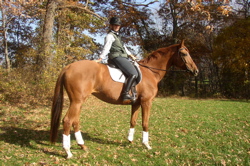 Danke, a tall and beautiful sensitive chestnut mare, came to me for training with quite a bit of emotional baggage as a result of some unsettling prior experiences in her life. One positive was, though, she arrived quite clicker-savvy because her owner used clicker training to teach her some tricks during several months of recuperation for an injury.
Danke, a tall and beautiful sensitive chestnut mare, came to me for training with quite a bit of emotional baggage as a result of some unsettling prior experiences in her life. One positive was, though, she arrived quite clicker-savvy because her owner used clicker training to teach her some tricks during several months of recuperation for an injury.
Danke is one of the most sensitive horses I’ve ever met. She has a strong sense of self-preservation. I discovered early on I could not pressure her do anything. Either she bought in or it was ‘no deal.’ If she was feeling vulnerable and other horses were nearby she might just stop and start kicking the unsuspecting victim. I had to be very careful who was riding nearby.
Clicker training was instrumental to her recovery. There were quite a few holes in Danke’s training, so quite a bit of time was spent doing groundwork, longeing, and noodling under saddle in order to get all the little bits and pieces that worried her straightened out. But straighten out they did and now she is such a lovely horse to ride.
One of the most interesting parts of her story had to do with how I resolved a problem she had with cantering, especially to the left. Whenever Danke was asked for canter to the left, she immediately threw her whole body, stiff as a board, to the left. No matter how well things appeared to be going prior to asking for the canter left, as soon as she THOUGHT that we were going to canter she did the same thing.
During longeing, I had discovered that she was quite responsive to a “kiss” signal to canter. I decided that to resolve the problem under saddle I would do “nothing” to ask for canter in any “normal” way (with legs and seat); instead, I would sit upright with a very relaxed seat and just “kiss” for the canter. Before it could go bad, I would click the instant she thought about cantering. I could feel her start to take the first step with the outside hind. Of course she stopped mid-stride when I clicked. I fed her a lump of sugar and then set her up to canter again in the same way as before. Again I’d kiss and again I’d click the instant she thought about cantering. I repeated the procedure, again and again. Each time, though, I let her canter a little longer before I clicked. Again and again, I’d click, stop, and treat for “thinking of cantering,” “a step of canter,” “two steps of canter,” “a quarter of a circle of canter,” “half a circle of canter,” and finally “a whole circle of canter.” I continued in this manner day after day.
Of course, every day I was also clicking her for accepting my leg for forward movement, clicking for slow down, clicking for accepting turning aids. Little by little, when it came time to canter, I would begin to notice that she would accept my leg aid to request that she continue to canter, and I’d click that. Then I started to integrate some downward transitions, and I’d click those. Then upward transitions back to canter using my leg and seat in a normal manner. Of course, I’d click those, too.
I continued like this for no less than three months. Yes to the casual on-looker it appeared that I wasn’t ‘doing’ anything. And I seem to spend a lot of time stopping to feed treats. I was often asked, can’t you just canter that horse yet? I’d just smile and say, nope not yet. Every day, if she said she couldn’t do it, I would return to clicking for one stride. But bit by bit, it got better and better, until one day the problem was simply gone. Today she has a beautiful canter and is happy to pick it up when asked from trot or walk. This is just one example of rewarding the behavior you want and taking the time it takes. And having more than just a “little” faith in the process!
‘doing’ anything. And I seem to spend a lot of time stopping to feed treats. I was often asked, can’t you just canter that horse yet? I’d just smile and say, nope not yet. Every day, if she said she couldn’t do it, I would return to clicking for one stride. But bit by bit, it got better and better, until one day the problem was simply gone. Today she has a beautiful canter and is happy to pick it up when asked from trot or walk. This is just one example of rewarding the behavior you want and taking the time it takes. And having more than just a “little” faith in the process!
